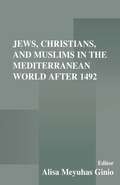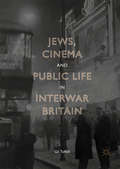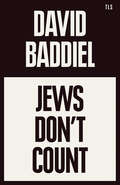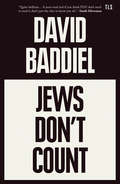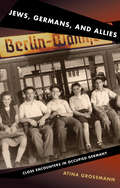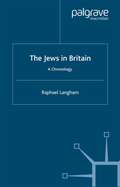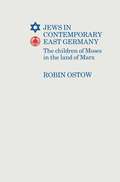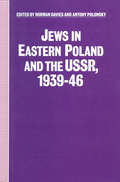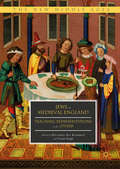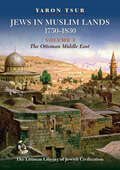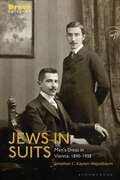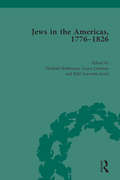- Table View
- List View
The Jew's Body
by Sander GilmanDrawing on a wealth of medical and historical materials, Sander Gilman sketches details of the anti-Semitic rhetoric about the Jewish body and mind, including medical and popular depictions of the Jewish voice, feet, and nose. Case studies illustrate how Jews have responded to such public misconceptions as the myth of the cloven foot and Jewish flat-footedness, the proposed link between the Jewish mind and hysteria, and the Victorians' irrational connection between Jews and prostitutes. Gilman is especially concerned with the role of psychoanalysis in the construction of anti-Semitism, examining Freud's attitude towards his own Jewishness and its effect on his theories, as well as the supposed "objectiveness" of psychiatrists and social scientists.
Jews, Christians, and Muslims in the Mediterranean World After 1492
by Alisa Meyuhas GinioThe expulsion of the Jews, and later the Muslims from the Iberian Peninsula marked the beginning of a new era in the life of the Mediterranean world. The articles in this volume discuss the aftermath of the crucial historical events that took place in the Mediterranean world in 1492, focusing on the social, economic and cultural consequences of these occurrences.
Jews, Christians, and Muslims in the Mediterranean World After 1492
by Alisa Meyuhas GinioThe expulsion of the Jews, and later the Muslims from the Iberian Peninsula marked the beginning of a new era in the life of the Mediterranean world. The articles in this volume discuss the aftermath of the crucial historical events that took place in the Mediterranean world in 1492, focusing on the social, economic and cultural consequences of these occurrences.
Jews, Cinema and Public Life in Interwar Britain
by Gil ToffellThis book investigates a Jewish orientation to film culture in interwar Britain. It explores how pleasure, politics and communal solidarity intermingled in the cinemas of Jewish neighbourhoods, and how film was seen as a vessel through which Jewish communal concerns might be carried to a wider public. Addressing an array of related topics, this volume examines the lived expressive cultures of cinemas in Jewish areas and the ethnically specific films consumed within these sites; the reception of film stars as representations of a Jewish social body; and how an antisemitic canard that understood the cinema as a Jewish monopoly complicated its use as a base for anti-fascist activity. In shedding light on an unexplored aspect of British film reception and exhibition, Toffell provides a unique insight into the making of the modern city by migrant communities. The title will be of use to anyone interested in Britain’s interwar leisure landscape, the Jewish presence in modernity, and a cinema studies sensitised to the everyday experience of audiences.
Jews Don’t Count
by David Baddiel‘The whole book is just brilliant – and very much needed.’ SIMON SCHAMA ’Such a good, important and essential book. SIMON SEBAG MONTEFIORE ‘Funny, complex and intellectually satisfying — a really good piece of work’FRANKIE BOYLE
Jews Don’t Count
by David BaddielNorth American Edition of the UK Bestseller How identity politics failed one particular identity. ‘a must read and if you think YOU don’t need to read it, that’s just the clue to know you do.’ SARAH SILVERMAN ‘This is a brave and necessary book.’ JONATHAN SAFRAN FOER ‘a masterpiece.’STEPHEN FRY
Jews, Germans, and Allies: Close Encounters in Occupied Germany
by Atina GrossmannIn the immediate aftermath of World War II, more than a quarter million Jewish survivors of the Holocaust lived among their defeated persecutors in the chaotic society of Allied-occupied Germany. Jews, Germans, and Allies draws upon the wealth of diary and memoir literature by the people who lived through postwar reconstruction to trace the conflicting ways Jews and Germans defined their own victimization and survival, comprehended the trauma of war and genocide, and struggled to rebuild their lives. In gripping and unforgettable detail, Atina Grossmann describes Berlin in the days following Germany's surrender--the mass rape of German women by the Red Army, the liberated slave laborers and homecoming soldiers, returning political exiles, Jews emerging from hiding, and ethnic German refugees fleeing the East. She chronicles the hunger, disease, and homelessness, the fraternization with Allied occupiers, and the complexities of navigating a world where the commonplace mingled with the horrific. Grossmann untangles the stories of Jewish survivors inside and outside the displaced-persons camps of the American zone as they built families and reconstructed identities while awaiting emigration to Palestine or the United States. She examines how Germans and Jews interacted and competed for Allied favor, benefits, and victim status, and how they sought to restore normality--in work, in their relationships, and in their everyday encounters. Jews, Germans, and Allies shows how Jews were integral participants in postwar Germany and bridges the divide that still exists today between German history and Jewish studies.
Jews, Germans, and Allies: Close Encounters in Occupied Germany
by Atina GrossmannIn the immediate aftermath of World War II, more than a quarter million Jewish survivors of the Holocaust lived among their defeated persecutors in the chaotic society of Allied-occupied Germany. Jews, Germans, and Allies draws upon the wealth of diary and memoir literature by the people who lived through postwar reconstruction to trace the conflicting ways Jews and Germans defined their own victimization and survival, comprehended the trauma of war and genocide, and struggled to rebuild their lives. In gripping and unforgettable detail, Atina Grossmann describes Berlin in the days following Germany's surrender--the mass rape of German women by the Red Army, the liberated slave laborers and homecoming soldiers, returning political exiles, Jews emerging from hiding, and ethnic German refugees fleeing the East. She chronicles the hunger, disease, and homelessness, the fraternization with Allied occupiers, and the complexities of navigating a world where the commonplace mingled with the horrific. Grossmann untangles the stories of Jewish survivors inside and outside the displaced-persons camps of the American zone as they built families and reconstructed identities while awaiting emigration to Palestine or the United States. She examines how Germans and Jews interacted and competed for Allied favor, benefits, and victim status, and how they sought to restore normality--in work, in their relationships, and in their everyday encounters. Jews, Germans, and Allies shows how Jews were integral participants in postwar Germany and bridges the divide that still exists today between German history and Jewish studies.
The Jews in Britain: A Chronology
by R. LanghamFor nearly a thousand years there has been a Jewish presence in Britain. Today the Jewish community, although numbering less than 300,000 is widely seen as one of the most successful groups in Britain. This unique book describes events in Britain concerning Jews in chronological order, from ancient legend to the present times.
Jews in Britain (Shire Library #734)
by Michael Leventhal Richard GoldsteinThis book tells the epic thousand-year story of Britain's Jewish community, the country's oldest minority group, replete with the dark episodes of persecution and expulsion, but also with positive periods of acceptance and toleration. Some Jews came as wealthy traders, others as desperate refugees; some had to lead secret lives, and others in different times stood shoulder to shoulder with the rest of the nation against threats to the British way of life, which included the Nazis. The impact of Jewish culture on daily life – on language, on food, on religion, art and business – has been inestimable, and this book is a fully illustrated introduction and fitting tribute.
Jews in Britain (Shire Library)
by Michael Leventhal Richard GoldsteinThis book tells the epic thousand-year story of Britain's Jewish community, the country's oldest minority group, replete with the dark episodes of persecution and expulsion, but also with positive periods of acceptance and toleration. Some Jews came as wealthy traders, others as desperate refugees; some had to lead secret lives, and others in different times stood shoulder to shoulder with the rest of the nation against threats to the British way of life, which included the Nazis. The impact of Jewish culture on daily life – on language, on food, on religion, art and business – has been inestimable, and this book is a fully illustrated introduction and fitting tribute.
Jews in Contemporary East Germany: The Children of Moses in The Land of Marx
by Robin OstowThis book is the result of a series of interviews of Robin Ostow with Jews in the German Democratic Republic. For the first time since the founding of the East German state in 1949 Jews have been allowed to speak openly. Jewish men and women of different ages were interviewed.
Jews in Eastern Poland and the USSR, 1939-46 (Studies in Russia and East Europe)
by Norman Davies Antony PolonskyThis book is the first to deal with the impact on the Jews of the area of the sovietization of Eastern Poland. Polish resentment at alleged Jewish collaboration with the Soviets between 1939 and 1941 affected the development of Polish-Jewish relations under Nazi rule and in the USSR. The role of these conflicts both in the Anders army and in the Communist-led Kosciuszko division and 1st Polish Army is investigated, as well as the part played by Jews in the communist-dominated regime in Poland after 1944.
Jews in Medieval England: Teaching Representations of the Other
by Miriamne Ara Krummel Tison PughThis volume examines the teaching of Jewishness within the context of medieval England. It covers a wide array of academic disciplines and addresses a multitude of primary sources, including medieval English manuscripts, law codes, philosophy, art, and literature, in explicating how the Jew-as-Other was formed. Chapters are devoted to the teaching of the complexities of medieval Jewish experiences in the modern classroom. Jews in Medieval England: Teaching Representations of the Other also grounds medieval conceptions of the Other within the contemporary world where we continue to confront the problematic attitudes directed toward alleged social outcasts.
Jews in Medieval England: Teaching Representations of the Other
by Miriamne Ara Krummel Tison PughThis volume examines the teaching of Jewishness within the context of medieval England. It covers a wide array of academic disciplines and addresses a multitude of primary sources, including medieval English manuscripts, law codes, philosophy, art, and literature, in explicating how the Jew-as-Other was formed. Chapters are devoted to the teaching of the complexities of medieval Jewish experiences in the modern classroom. Jews in Medieval England: Teaching Representations of the Other also grounds medieval conceptions of the Other within the contemporary world where we continue to confront the problematic attitudes directed toward alleged social outcasts.
Jews in Muslim Lands, 1750–1830: Volume I: The Ottoman Middle East (The Littman Library of Jewish Civilization)
by Yaron TsurThis fascinating tour of the Jewish communities of the Ottoman Middle East, on the eve of the changes that would come to unsettle the Ottoman territories, reveals a surprisingly varied world. Visiting Istanbul, Damascus, Acre, Jerusalem, Aleppo, Basra, and Cairo, we see different landscapes, meet diverse Jewish societies, and encounter the range of their economic activities. We also see how Christians and Jews struggled with each other to establish their position in the Muslim world and secure their livelihood. In the process, the author reconsiders fundamental questions. What is a ‘diaspora’? To what extent did the surrounding culture impact the Jewish communities of the area? And, most interestingly, how did these communities respond to the onset of modernity? Though relating to Jewish society in its entirety, the main focus is on its most powerful members: the notables, who were close to the ruling elite or involved in international trade. Tsur discusses their strengths and weaknesses, considers the relationship between their position and that of the rest of the Jewish community, and analyses their eventual downfall. His study offers new insights into the social mechanisms that enabled them to establish close ties with the ruling elite and to function within it.
Jews in Muslim Lands, 1750–1830: Volume I: The Ottoman Middle East (The Littman Library of Jewish Civilization)
by Yaron TsurThis fascinating tour of the Jewish communities of the Ottoman Middle East, on the eve of the changes that would come to unsettle the Ottoman territories, reveals a surprisingly varied world. Visiting Istanbul, Damascus, Acre, Jerusalem, Aleppo, Basra, and Cairo, we see different landscapes, meet diverse Jewish societies, and encounter the range of their economic activities. We also see how Christians and Jews struggled with each other to establish their position in the Muslim world and secure their livelihood. In the process, the author reconsiders fundamental questions. What is a ‘diaspora’? To what extent did the surrounding culture impact the Jewish communities of the area? And, most interestingly, how did these communities respond to the onset of modernity? Though relating to Jewish society in its entirety, the main focus is on its most powerful members: the notables, who were close to the ruling elite or involved in international trade. Tsur discusses their strengths and weaknesses, considers the relationship between their position and that of the rest of the Jewish community, and analyses their eventual downfall. His study offers new insights into the social mechanisms that enabled them to establish close ties with the ruling elite and to function within it.
Jews in Nineteenth-Century Britain: Charity, Community and Religion, 1830-1880
by Alysa LeveneThis book examines Jewish communities in Britain in an era of immense social, economic and religious change: from the acceleration of industrialisation to the end of the first phase of large-scale Jewish immigration from Europe. Using the 1851 census alongside extensive charity and community records, Jews in Nineteenth-Century Britain tests the impact of migration, new types of working and changes in patterns of worship on the family and community life of seven of the fastest-growing industrial towns in Britain. Communal life for the Jews living there (over a third of whom had been born overseas) was a constantly shifting balance between the generation of wealth and respectability, and the risks of inundation by poor newcomers. But while earlier studies have used this balance as a backdrop for the story of individual Jewish communities, this book highlights the interactions between the people who made them up. At the core of the book is the question of what membership of the 'imagined community' of global Jewry meant: how it helped those who belonged to it, how it affected where they lived and who they lived with, the jobs that they did and the wealth or charity that they had access to. By stitching together patterns of residence, charity and worship, Alysa Levene is here able to reveal that religious and cultural bonds had vital functions both for making ends meet and for the formation of identity in a period of rapid demographic, religious and cultural change.
Jews in Nineteenth-Century Britain: Charity, Community and Religion, 1830-1880
by Alysa LeveneThis book examines Jewish communities in Britain in an era of immense social, economic and religious change: from the acceleration of industrialisation to the end of the first phase of large-scale Jewish immigration from Europe. Using the 1851 census alongside extensive charity and community records, Jews in Nineteenth-Century Britain tests the impact of migration, new types of working and changes in patterns of worship on the family and community life of seven of the fastest-growing industrial towns in Britain. Communal life for the Jews living there (over a third of whom had been born overseas) was a constantly shifting balance between the generation of wealth and respectability, and the risks of inundation by poor newcomers. But while earlier studies have used this balance as a backdrop for the story of individual Jewish communities, this book highlights the interactions between the people who made them up. At the core of the book is the question of what membership of the 'imagined community' of global Jewry meant: how it helped those who belonged to it, how it affected where they lived and who they lived with, the jobs that they did and the wealth or charity that they had access to. By stitching together patterns of residence, charity and worship, Alysa Levene is here able to reveal that religious and cultural bonds had vital functions both for making ends meet and for the formation of identity in a period of rapid demographic, religious and cultural change.
Jews in Nineteenth-Century Egypt (Routledge Library Editions: Society of the Middle East)
by Jacob M. LandauAlthough nineteenth-century Egyptian Jewry was an active and creative part of society, this work from 1969 is the main comprehensive work devoted to an analysis and appraisal of its activities. The period under review commences with the fall of the Mamluk regime in Egypt, and the incipient modernization of the state, with the resulting increase in Jewish activity. It terminates with the end of World War I and the new era in the history of modern Egypt, an era of extreme nationalism that led to the undermining of the Jewish community.
Jews in Nineteenth-Century Egypt (Routledge Library Editions: Society of the Middle East)
by Jacob M. LandauAlthough nineteenth-century Egyptian Jewry was an active and creative part of society, this work from 1969 is the main comprehensive work devoted to an analysis and appraisal of its activities. The period under review commences with the fall of the Mamluk regime in Egypt, and the incipient modernization of the state, with the resulting increase in Jewish activity. It terminates with the end of World War I and the new era in the history of modern Egypt, an era of extreme nationalism that led to the undermining of the Jewish community.
The Jews in Poland and Russia: A Short History (The Littman Library of Jewish Civilization)
by Antony PolonskyFor many centuries Poland and Russia formed the heartland of the Jewish world: right up to the Second World War the area was home to over 40 per cent of the world's Jews. Nearly three and a half million Jews lived in Poland alone, with nearly three million more in the Soviet Union. Yet although the majority of the Jews of Europe and the United States, and a large proportion of the Jews of Israel, originate from these lands, and many of the major movements that have characterized the Jewish world in recent times have their origins there, the history of their Jewish communities is not well known. Rather, it is the subject of mythologizing that fails both to bring out the specific features of the Jewish civilization that emerged there and to illustrate what was lost in its destruction: Jewish life in these parts, though often poor materially, was marked by a high degree of spiritual and ideological intensity and creativity. Antony Polonsky re-creates this lost world - brutally cut down by the Holocaust and seriously damaged by the Soviet attempt to destroy Jewish culture - in a study that avoids both sentimentalism and the simplification of the east European Jewish experience into a story of persecution and martyrdom. It is an important story whose relevance reaches far beyond the Jewish world or the bounds of east-central Europe, and Professor Polonsky succeeds in providing a comprehensive overview that highlights the realities of Jewish life while also setting them in the context of the political, economic, and social realities of the time. He describes not only the towns and shtetls where the Jews lived, the institutions they developed, and their participation in the economy, but also their vibrant religious and intellectual life, including the emergence of hasidism and the growth of opposition to it from within the Jewish world. By the late eighteenth century other factors had come into play: with the onset of modernization there were government attempts to integrate and transform the Jews, and the stirrings of Enlightenment led to the growth of the Haskalah movement that was to revolutionize the Jewish world. Polonsky looks at developments in each area in turn: the problems of emancipation, acculturation, and assimilation in Prussian and Austrian Poland; the politics of integration in the Kingdom of Poland; and the failure of forced integration in the tsarist empire. He then shows how the deterioration in the position of the Jews between 1881 and 1914 encouraged a range of new movements - Zionism, socialism, and autonomism - as well as the emergence of modern Hebrew and Yiddish literature. He also examines Jewish urbanization and the rise of Jewish mass culture. The final part of the volume deals with the twentieth century. Starting from the First World War and the establishment of the Soviet Union, it looks in turn at Poland, Lithuania, and the Soviet Union up to the Second World War. It then reviews Polish - Jewish relations during the war and examines the Soviet record in relation to the Holocaust. The final chapters deal with the Jews in the Soviet Union and in Poland since 1945, concluding with an epilogue on the Jews in Poland, Lithuania, Belarus, Ukraine, and Russia since the collapse of communism. This is an abridged version of a three-volume hardback edition which won the 2011 Kulczycki Book Prize for Polish Studies (awarded by the American Association for Slavic, East European, and Eurasian Studies) and also the Pro Historia Polonorum Prize for the best book on the history of Poland published in a foreign language between 2007 and 2011 (a prize established by the Polish Senate and awarded by the Polish Historical Association).
Jews in Suits: Men's Dress in Vienna, 1890-1938 (Dress Cultures)
by Jonathan C. Kaplan-WajselbaumSurviving photographs of Jewish Viennese men during the fin-de-siècle and interwar periods – both the renowned cultural luminaries and their many anonymous coreligionists – all share a striking sartorial detail: the tailored suit. Yet, until now, the adoption of the tailored suit and its function in the formation of modern Jewish identities remains under-researched.Jews in Suits uses a rich range of written and visual sources, including literary fiction and satire, 'ego-documents', photography, trade catalogues, invoices, and department store culture, to propose a new narrative of men, fashion, and their Jewish identities. It reveals that dressing in a modern manner was not simply a matter of assimilation, but rather a way of developing new models of Jewish subjectivity beyond the externally prescribed notion of 'the Jew'. Drawing upon fashionable dress, folk costume, religious dress, avant-garde, oppositional dress, typologies which are often considered separate from one another, it proposes a new way of reading men and clothing cultures within an iconic cultural milieu, offering insights into the relationship of clothing and grooming to the understanding of the self.
Jews in Suits: Men's Dress in Vienna, 1890-1938 (Dress Cultures)
by Jonathan C. Kaplan-WajselbaumSurviving photographs of Jewish Viennese men during the fin-de-siècle and interwar periods – both the renowned cultural luminaries and their many anonymous coreligionists – all share a striking sartorial detail: the tailored suit. Yet, until now, the adoption of the tailored suit and its function in the formation of modern Jewish identities remains under-researched.Jews in Suits uses a rich range of written and visual sources, including literary fiction and satire, 'ego-documents', photography, trade catalogues, invoices, and department store culture, to propose a new narrative of men, fashion, and their Jewish identities. It reveals that dressing in a modern manner was not simply a matter of assimilation, but rather a way of developing new models of Jewish subjectivity beyond the externally prescribed notion of 'the Jew'. Drawing upon fashionable dress, folk costume, religious dress, avant-garde, oppositional dress, typologies which are often considered separate from one another, it proposes a new way of reading men and clothing cultures within an iconic cultural milieu, offering insights into the relationship of clothing and grooming to the understanding of the self.
Jews in the Americas, 1776-1826 (Routledge Historical Resources)
by Michael Hoberman Laura Leibman Hilit Surowitz-IsraelThe period between 1776-1826 signalled a major change in how Jewish identity was understood both by Jews and non-Jews throughout the Americas. Jews in the Americas, 1776-1826 brings this world of change to life by uniting important out-of-print primary sources on early American Jewish life with rare archival materials that can currently be found only in special collections in Europe, England, the United States, and the Caribbean.

